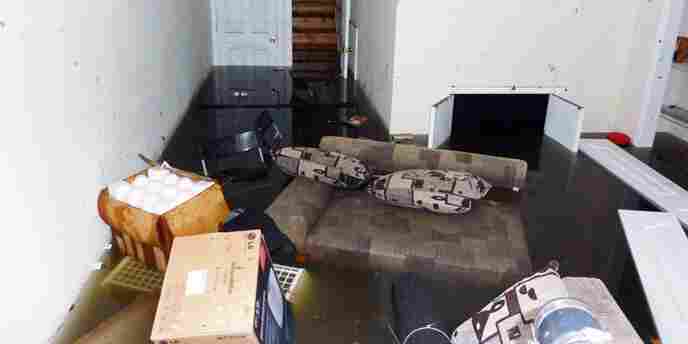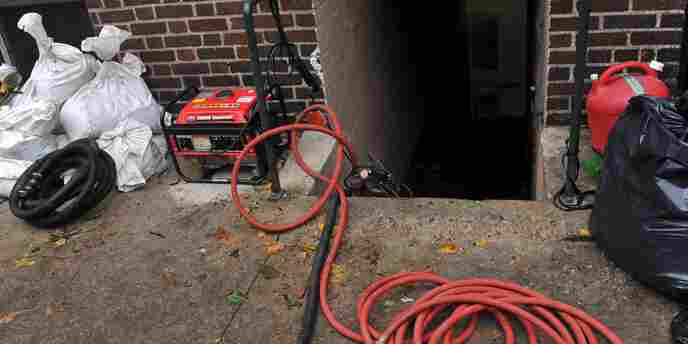Discovering a flooded basement would fill any homeowner with dread. Most people don’t plan for this unwelcome surprise, but when it happens, you need to act fast in order to limit the damage.
If water is currently coming into your basement, you should exercise extreme caution and follow the first step before taking additional action. Then, follow these steps to find the source of the flood, get water out of the basement and start cleaning up.
How to Dry and Clean Up a Flooded Basement in 5 Steps
1. Make Sure Your Basement is Safe to Enter
The first thing you need to do when your basement floods is assess the situation. There’s risk of electric shock if the water is high enough to come in contact with an outlet or electrical wiring.
“If the water in your basement is more than a puddle and water continues to flow in, the first thing you need to do is think about your safety. If you believe electrical appliances or outlets are already underwater and you cannot walk through the basement without coming in contact with water, do not enter the basement. The most important thing to know is that as bad as the problem seems, it can get worse for you if you’re not careful.”
Paul Abrams | Public Relations Director, Roto-Rooter Services Co.
Check for these signs to determine if your flooded basement is safe to enter:
Once you’ve confirmed the basement flooding doesn’t pose an electrical or gas-related hazard, or you’ve taken care of these issues, you can move on to the following steps.
2. Find the Source of the Basement Flood
Try to determine why your basement is flooding and stop it. Even if you can’t stop the flood, you’ll save precious time if you’re able to inform your plumber or contractor about the source of the water as soon as they arrive.
How do you find the source of your flood? Scan the area, and try to pinpoint how the water is getting in. These entry points are the most common culprits of basement floods:
Once you’ve determined the source of the flooding, and have possibly stopped the leak, you can move on to saving items from the flooded basement.
When your basement is flooded from heavy rain or severe weather, you may be facing more than just water damage. If you need to clean up after a storm, we can help with that as well.
Find more tips on basement flood cleanup and repairing water damage after a storm in our Essential Severe Weather Guide .
After figuring out the source of the flooding, and possibly stopping the leak, try to save items from water damage.

3. Start Salvaging Your Belongings
Once the area is safe to enter, move quickly through your flooded basement and unplug all electronics. This is an important safety measure to follow, especially if the water continues to rise. Paul Abrams of Roto-Rooter also advises, “Wear gloves and rubber boots if you enter a flooding basement.”
Then, start moving your belongings to higher ground. You won’t be able to move everything out of the basement, so prioritize the most important items to save.
Focus on items that are the most expensive or will be the hardest to replace, including:
4. Get the Water Out of Your Basement
The faster you can dry a wet basement, the better chance you have at preventing mold after a flood and other long-term damage to your home. Start by removing standing water. If it’s relatively shallow, you can work with mops and buckets.
If the standing water is several inches deep, you have a few options:
Your basement will still be damp when the standing water is gone. Here are a few tips to help speed up the drying process:

5. Start the Post-Flood Cleanup
Getting rid of any ruined belongings is a top priority in the basement flood cleanup process. You should not attempt to save:
If you’re questioning the safety of any item, call in a professional to make sure nothing you’re saving is at risk of growing mold or bacteria. Take pictures to document the water damage and your lost possessions at this point if you plan to file a home insurance claim .
Have a lot to get rid of after cleaning up? Consider a residential dumpster rental to easily dispose of your waste as you clear out the basement.
Tips to Prevent Mold After a Flood
Prevent Basement Flooding and Water Damage in the Future
After you’ve dealt with all the work and stress of a basement flood, it’s important to have a plan to prevent this from happening again in the future. Check out these helpful resources for tips and advice to keep your home dry:
